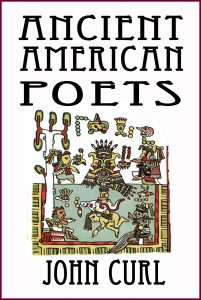PREFACE
The very idea of ancient American poets and poetry may sound strange to some ears. In the United States, American poetry is often taught as if it is an extension of English poetry. Yet there were rich traditions of poetry on this continent long before the first European colonists arrived.
Much of the oldest American poetry and literature has come down to us from early books and manuscripts in alphabetic Nahuatl (Aztec), Maya, and Quechua ( Inca), written by the people themselves. The Flower-Songs of Nezahualcoyotl (Nahua-Aztec), the Songs of Dzitbalché (Yucatec Maya) and the Sacred Hymns of Pachacutec (Inca) are probably all roughly contemporary, and all contain Indigenous poetry and culture from the mid-1400s, though the earliest extant manuscripts come from over a century later. Most of these poems were meant to be accompanied by music, which makes them “lyric” poetry in the original sense of the word.

Free pdf of ANCIENT AMERICAN POETS HERE
The sophisticated and cultured world that produced these Indigenous poets was disrupted and destroyed by conquest. The European invasion was followed by a concerted campaign by the conquerors to try to blot out all memory of the accomplishments of the native cultures. Native children were told that the colonizers did them a favor by destroying their culture. It is only in recent times, as the descendants of both colonized and colonizers struggle to heal our cultures today, that the world is ripe to appreciate the accomplishments of the Native civilizations. A large body of ancient and early indigenous literature has emerged, and more keeps appearing.
Nahuatl, Maya and Quechua were all once linguas francas, the common languages spoken over large areas, and are all still living languages, widely spoken today. Contemporary Nahuatl, Maya and Quechua have of course changed considerably from the languages in these poems, just as English has changed from the language of Shakespeare. Nahuatl speakers today total over 1.7 million, spread across central Mexico. The Mayan languages taken together total about seven million speakers in southern Mexico, Yucatán and Central America, with about 800,000 speaking Yucatec Maya. Quechua has between six and eight million speakers, mostly in Peru, Bolivia and Ecuador.
The apparent divide between Anglo America and Latin America follows the boundaries of colonialism, not of Native culture. There has always been a cultural continuity between the northern and southern Native nations. The resurgence of Indigenous consciousness today, both north and south, makes this clear. These poets and poems are really part of our Pan-American cultural heritage, our American roots. Iit is important for us today to reclaim, as much as possible, knowledge of the world that was destroyed, for the sake of our common future. The Flower-songs of Nezahualcoyotl, the Songs of Dzitbalché and the Sacred Hymns of Pachacutec are the heritage of us all, and deserve to take their places as classics of American literature. I hope these translations reflect some of the brilliant light of the original poems.
Composer Tania Leon used some of my transcriptions and translations as the libretto for a piece entitled Ancients, for two sopranos, flute, clarinet, percussion, viola and cello, which was performed and published in 2008. Music groups Lovetaxi and Dancing Deadlips have recorded songs and tracts using these translations. Some of these translations are also available on the FAMSI website.
Free pdf of the book ANCIENT AMERICAN POETS HERE
IT IS PURE JADE by Nezahualcoyotl
It is pure jade, a wide plumage, your heart,
your word, O Father! Ehuaya.
You pity man, you watch him with mercy!
Only for the most brief moment is he next to you,
at your side! Ohuaya, ohuyaya.
Precious as jade your flowers burst forth,
O Life Giver.
As fragrant flowers they are perfected,
as blue parrots they open their corollas.
Only for the most brief moment next to you,
at your side! Ohuaya, ohuyaya.
THOSE WHO BUILD HOUSES AND TEMPLES by Ah Bam
Essential
to count the haab years or katuns
that have passed since
the great powerful men
raised the walls of the ancient cities
that we see now
here in the Province of the Plains,
all these cities scattered
on the earth
here and there, on high hills.
Here in the cities, we try to give
meaning to what we see today in the skies
and what we know;
for day to day
at midday
we see in the skies
the signs told to us by
the ancient people of this land,
the ancient people of these villages
here on our earth.
Let us purify our hearts
so at nightfall,
and at midnight,
from horizon to zenith
we may read the face of the sky.
HYMN ONE by Pachacutec
Oh Creator, root of all,
Wiracocha, end of all,
Lord in shining garments
who infuses life
and sets all things in order,
saying,
“Let there be man!
Let there be woman!”
Molder, maker,
to all things you have given life:
watch over them,
keep them living prosperously,
fortunately
in safety and peace.
Where are you?
Outside? Inside?
Above this world in the clouds?
Below this world in the shades?
Hear me! Answer me!
Take my words to your heart!
For ages without end
let me live,
grasp me in your arms,
hold me in your hands,
receive this offering
wherever you are, my Lord,
my Wiracocha.

0 Comments